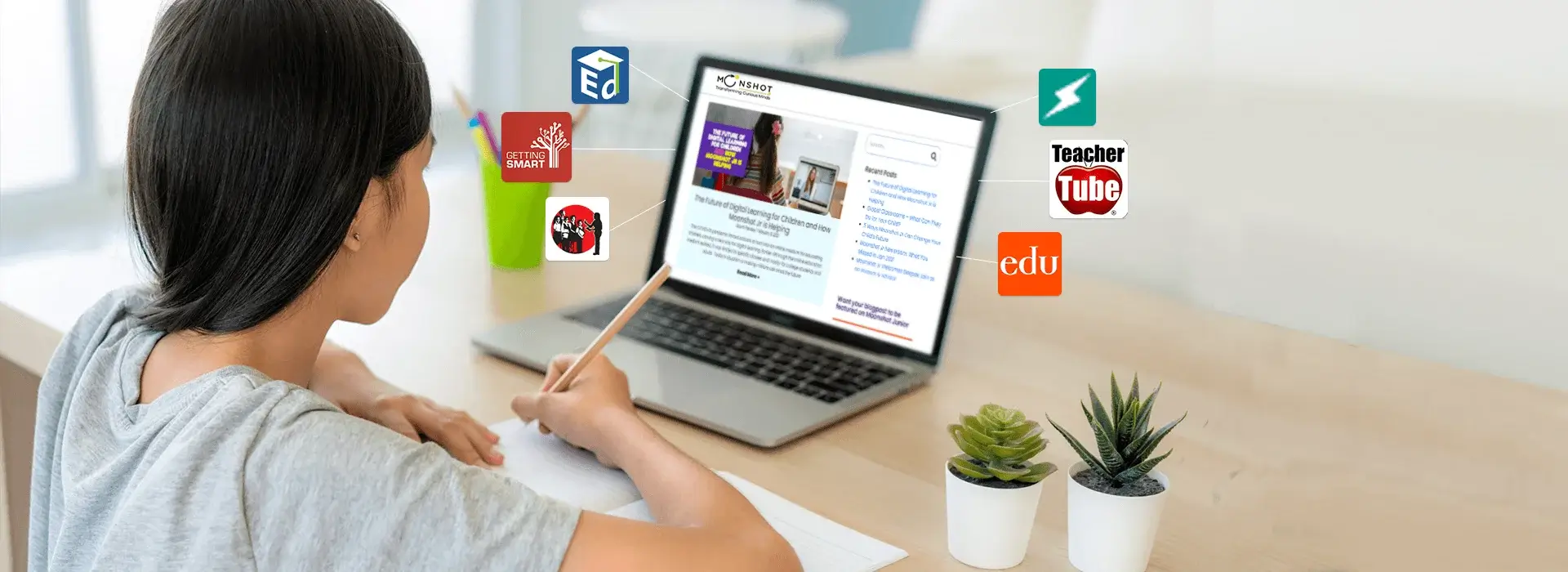Update: This article was last updated on 17th December 2024 to reflect the accuracy and up-to-date information on the page.

In today’s world, knowing how to code is becoming increasingly valuable. Python combines symbols and acronyms, so even children with no programming experience can learn it. This makes it the best programming language to teach children.
If you are keen, you can unlock your child’s potential with Python, the coding language taking the world by storm. But before that, let’s dive in to know the basics:
What is Python?
High-level programming languages like Python are popular because of their readability and adaptability. Python is accessible to developers of all skill levels because of its clarity and syntax simplicity.
Python is appropriate for a wide range of applications due to its huge standard library and support for numerous programming paradigms.
Its interpreted nature enables quick testing, and being platform-independent allows it to run on various operating systems. It is prevalent in web development, data science, and artificial intelligence, supported by popular frameworks and libraries like Django, Flask, NumPy, and TensorFlow.
Why Should a Kid Learn Python?
Python is extensively utilized in many different fields, is easy to learn, and is adaptable. Its simple syntax encourages students to think logically and solve problems, preparing them for chances in STEM fields in the future.
Python’s engaging projects, supportive community, and abundance of educational resources make it an ideal language for young learners.
It introduces computational thinking and provides a solid foundation for exploring different areas of technology, ensuring that kids are well-equipped for the digital future.
Is Python easy to learn?
Python’s simple syntax, readability, versatility, and robust community support have earned it a reputation as one of the most beginner-friendly programming languages. Because of its widespread use in academia and industry, it’s a good alternative for those who are new to programming.
What is the right age to learn Python?
There’s no specific age to start learning programming; it depends on individual interest and readiness. For young children (5-10), visual programming languages can introduce basic concepts.
Python is a suitable language for pre-teens (ages 11–13) to explore more sophisticated ideas because of its readability. Teens (ages 14 to 17) can explore complex ideas and practical applications.
Adults can start learning to program at any age, with Python being accessible for beginners, whether for skill acquisition or career change. The key is to encourage curiosity and interest in logical thinking.
Now let’s quickly find the best 5 ways in which Kids could learn python:
1. Online classes
You don’t need to travel far to get started because there are plenty of internet resources for teaching Python to children. Choose the course that best meets your child’s needs by doing some research.
Some handpicked online learning platforms:
- CodeWizardsHQ: It offers weekly live, teacher-led sessions in Python coding for children and teenagers ages 8 to 18, and it covers various topics from basic to advanced.
- FreeCodeCamp: A free online course that teaches Python programming basics through enjoyable, engaging exercises.
- Moonpreneur: They are offering a 4-week summer camp on Programming with Python to help your child spend their summer time in the best effective ways.
- Tynker: A platform for self-paced online learning, it provides gamified courses and interactive projects to make learning Python enjoyable and interesting.
- edX: Here, you may find a variety of Python courses for kids, including a Python for Data Science Bootcamp, Python Fundamentals for Kids, and an introduction to Python for Data Science.
2. Practice writing Python code
As they say, practice makes perfect. So children can hone skills in writing Python code through consistent practice and experimentation.
- Solve coding challenges: Python coding challenges can be found on websites like HackerRank, LeetCode, and CodeWars. Your knowledge of Python syntax, data structures, algorithms, and problem-solving abilities will be put to the test by these exercises.
- Practice Python exercises: On websites like Practice Python and Python Basic Exercises, you can find a selection of beginner- and intermediate-level Python projects and tasks.
- Contribute to open-source projects: This is a fantastic opportunity to collaborate with other developers and work on actual Python projects. You can contribute to a variety of open-source projects on websites like GitHub and GitLab.
- Build personal projects: Nothing can be more beneficial than a hands-on learning experience. Also, creating personal projects is an excellent method to learn by doing. While working on something you’re enthusiastic about, practice writing Python code. Choose a project you want to construct and utilize Python to carry it out.
- Read and analyze Python code: Reading and analyzing existing Python code can be a great way to learn new coding techniques and best practices. Look for open-source projects or code snippets that you find interesting and try to understand how they work.
Overall, the key to getting better at writing Python code is to practice regularly and challenge yourself with new coding problems and projects.
3. Learn to debug
Speaking of bugs, they are unavoidable. Everyone faces it. Don’t let bugs sap your motivation. Instead, relish them and think of yourself as a bug hunter. Here are a few techniques for debugging Python code:
- Built-in pdb module: This module provides an interactive source code debugger for Python programs.
- Python IDE: Many Python IDEs such as PyCharm, Visual Studio Code, and Spyder have built-in debugging tools.
- Online Python debugger: Several online IDEs such as Python Tutor and OnlineGDB provide an interactive Python debugger.
- Third-party debugging tools: Python supports several third-party debugging tools, including PyDev, WinPdb, and Wing. These tools include sophisticated debugging features like code profiling, remote debugging, and code coverage analysis.
Each method has its advantages and disadvantages, and the choice of method depends on the specific debugging needs and the developer’s preference.
4. Explore with Gamification
Gamification is the process of incorporating aspects and ideas from games into non-gaming environments to encourage and engage users. Gamification has the potential to improve learning when it comes to technical areas like programming:
- Motivation: Gamification taps into natural motivation, using elements like points and rewards to keep learners engaged and motivated.
- Immediate Feedback: Games provide instant feedback, helping learners understand their progress and areas for improvement.
- Progress Tracking: Visual indicators, such as progress bars and levels, allow learners to track their advancement, setting goals and boosting motivation.
- Competition and Collaboration: Incorporating elements like leaderboards and team challenges fosters healthy competition and collaboration among learners.
- Problem-Solving Skills: Gamification encourages critical thinking and problem-solving by presenting educational content as interactive challenges or puzzles.
5. Create something
Improving your muscle memory and confidence with Python is achievable through simple exercises. After mastering fundamental concepts such as data structures, object-oriented programming, and class creation, it’s crucial to start the building process.
Although reading articles and classes in Python can provide a foundation, the most effective way to learn is through constructing something with Python. As you solve problems during the building process, you will learn the majority of what you need to know about Python.
Once you master these learning tactics, you’re ready to embark on your Python adventure!
Gamify Your Python Learning!
Learning Python is fun, and what better way to start than with a simple challenge? Try this:
Challenge:
Write a Python program to print numbers from 1 to 10.
Hint: Use a loop to iterate through the numbers.
Take a moment to try it yourself!
Solution:
Here’s how you can write the program:
# Program to print numbers from 1 to 10
for number in range(1, 11):
print(number)
When you run this program, the output will look like this:
1
2
3
4
5
6
7
8
9
10
Moonpreneur is on a mission to disrupt traditional education and future-proof the next generation with holistic learning solutions. Its Innovator Program is building tomorrow’s workforce by training students in AI/ML, Robotics, Coding, IoT, and Apps, enabling entrepreneurship through experiential learning.

























After learning the fundamentals of Python, what practical uses may children study?
Python’s flexibility means kids can try different things, like making simple games, making websites, or taking care of mundane tasks. Working on projects that are related to their interests helps them get better at understanding and using Python.
Are there any kid-friendly Python learning materials available, and how can parents evaluate their performance?
Lots of resources are made just for kids, like coding games, tutorials, and even visual programming interfaces. If you’re a parent, make sure you’re looking for a platform that’s fun and educational at the same time, with good reviews and a clear path to learning.
How can parents deal with any difficulties or annoyances their child might have while learning Python?
It is important to emphasize that coding is an iterative process, where errors are an integral part of the learning curve. It is important to foster resilience and problem-resolution by presenting challenges as opportunities for development. If challenges remain, consider seeking help from online coding communities, coding forums, or mentors.